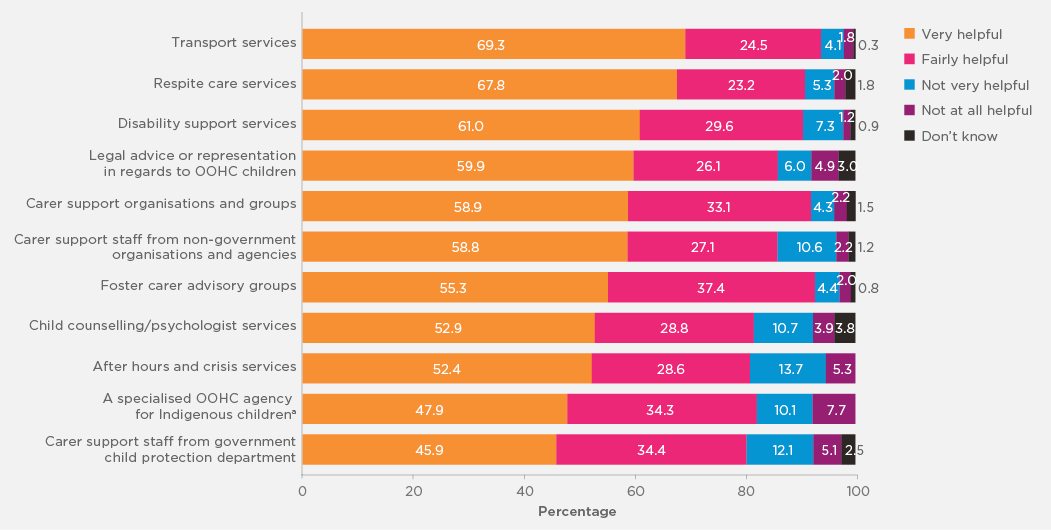Working Together to Care for Kids: Carer service use and needs
2 of 5
May 2018
Download Research snapshot
Overview
Service support plays an important role in helping carers to cope with the care demands of having an out-of-home-care child. This Research Snapshot focuses on carers' reports on their access to and views on service support.1
1 The information in this Research Snapshot is based on Working Together to Care for Kids: A Survey of Foster and Relative/Kinship Carers, which collected data from 2,203 foster and relative/kinship carers in 2016 via telephone interview. The survey was conducted by the Australian Institute of Family Studies (AIFS) in 2016, in collaboration with the Australian Government Department of Social Services (DSS), and funded by DSS. The sample was drawn from foster and relative/kinship carers who registered in the states/territories (except Northern Territory) as formal carers of out-of-home-care children aged 0-17 years old at 31 December 2015.
Key messages
-
Overall, over two-thirds of carers had had contact with at least one type of service in the past six months, with counselling/psychologist services, carer support staff from a government child protection department and respite care services being most common. Relative/kinship carers were less likely than foster carers to report contact with most services.
-
Carers tended to have positive views of the services they had used, especially transport services and respite care services.
-
The data suggest various service needs that had not been met for carers, with needs for carer support staff from the government child protection department, child counselling/psychologist services and carer support organisations and groups, and respite care services being most prominent.
-
Significant numbers of carers reported having difficulties in receiving the professional support they needed (nearly four in ten of all carers). Long waiting lists/support staff availability was most commonly reported as reasons for feeling this way.
Types of services used by carers
Carers were initially asked about whether they had ever used various types of services while a child was in their care as part of an out-of-home-care placement. For the services that carers reported using in the past, they were then asked whether they had used the service in the past six months (or for study children who were no longer in the household, whether they were used in the last six months the child was present in the household).
Table 1 present the proportion of carers that had used each type of service in the past six months:
- The most common types of services that carers had contacted with in the past six months were child counselling/psychologist services (33%), carer support staff from a government child protection department (25%) and respite care services (20%).
- Overall, over two-thirds of carers had contacted at least one type of service in the past six months.
- There were large discrepancies between foster and relative/kinship carers in their level of service usage, with foster carers tending to report higher contact with most services than relative/kinship carers.
| Foster (%) | Relative/kinship (%) | All (%) | |
|---|---|---|---|
| Carer support staff from government child protection department | 24.5 | 25.8 | 25.1 |
| Carer support teams from non-government organisations and agencies | 33.6 | 12.9 | 22.7 |
| Foster carer advisory groups | 9.6 | 4.2 | 6.7 |
| Carer support organisations and groups | 12.8 | 6.2 | 9.3 |
| After hours and crisis services | 9.1 | 1.9 | 5.3 |
| Respite care services | 29.7 | 11.7 | 20.2 |
| Child counselling/psychologist services | 42.2 | 24.1 | 32.6 |
| Disability support services | 12.3 | 5.7 | 8.8 |
| Transport services | 15.2 | 7.2 | 11.0 |
| Legal advice or representation in regards to child/children | 4.5 | 4.1 | 4.3 |
| A specialised out-of-home-care agency for Aboriginal and/or Torres Strait Islander childa | 3.8 | 2.1 | 2.9 |
| Any of the above (incl. other) | 81.0 | 56.4 | 68.0 |
| Number of carers | 1,196 | 1,005 | 2,203 |
Notes: Percentages are based on weighted data and small numbers of respondents' "Don't know" answers were included in calculating percentages (0.01%-1% of all carers across the items listed). Sample sizes are unweighted. aOnly asked of study children earlier identified as being of Aboriginal and/or Torres Strait Islander origin.
The helpfulness of services used by carers
Carers who had used various services in the past six months were asked how helpful they had found each service. While carers tended to perceive the services they had used as being helpful (i.e., at least 80% of carers rated each type of service as being either "very" or "fairly" helpful), Figure 1 shows that there was some variation between the services in how helpful carers perceived them to be:
- The services that were most commonly identified as being "very helpful" were transport services and respite care services (68-69%). This could potentially be due to carers receiving an immediate benefit from these services, for example getting to where they need to with transport services or receiving some much-needed/appreciated temporary respite from their caring role.
- Carers' views on the helpfulness of the services received were relatively similar between foster and relative/kinship carers, despite the lower likelihood of relative/kinship carers using most types of services.
Figure 1: Carers' views on the helpfulness of services received for services used in the past six months

Notes: Percentages are based on weighted data. Unweighted sample sizes range from 131 to 750. a Only asked of study children earlier identified as being of Aboriginal and/or Torres Strait Islander origin.
Service needs and barriers faced by carers in receiving the support required
Analysis was conducted to identify carers' "unmet service needs"; these were defined as instances where carers reported they currently needed a service (or in the last six months the study child lived with them), but had not received it in the last six months or ever (Figure 2).
- The most common "unmet service need", which applied to one-quarter of carers, was carer support staff from the government child protection department (25%), followed by child counselling/psychologist services and carer support organisations and groups (both at 22%), and respite care services (19%).
- Overall, nearly two-thirds of carers had one type of service need that had not been met.
- Foster and relative/kinship carers were relatively similar regarding unmet service needs (not shown), although there were some differences:
- Foster carers were more likely than relative/kinship carers to indicate an unmet need for a number of services, including foster care advisory groups, after-hours and crisis services, and disability support services.
Figure 2: Carers with unmet service needs (i.e., currently needed the service, but had not received it in the past six months or ever)

Notes: Percentages are based on weighted data. aOnly asked of study children earlier identified as being of Aboriginal and/or Torres Strait Islander origin.
Carers who reported having required one or more types of services (including those currently used) were asked about whether they had any difficulty in getting the professional service/support they needed.
- Just under half (47%) of carers who reported having a current need for services said they had some difficulty in receiving the required support (equivalent to 37% of all carers), with results similar between foster and relative/kinship carers.
Those who had difficulties were asked about the reasons and their responses are shown in Table 2:
- Overall, by far the most common barrier to receiving services identified by carers was long waiting lists/support staff availability (at 46%).
- Not being aware of what was available (27%), no appropriate services (22%), the service cost (21%) and agency problems (e.g., bureaucracy, poor communication) were the other most commonly identified barriers.
- There were relatively few differences between foster and relative/kinship carers in regards to factors that made it difficult to receive the services they needed but a slightly higher proportion of relative/kinship carers than foster carers identified not being aware of what was available as a factor.
| Foster (%) | Relative/ kinship (%) | All (%) | |
|---|---|---|---|
| No appropriate services | 23.1 | 20.5 | 21.9 |
| Worried seeking support may lead people to think you are incapable | 6.4 | 5.2 | 5.8 |
| Too far to travel/problems with transport | 15.6 | 12.7 | 14.2 |
| Long waiting lists/support staff availability | 48.8 | 43.9 | 46.4 |
| Cost of the service | 21.5 | 20.7 | 21.1 |
| Not aware of what's available | 23.1 | 31.6 | 27.2 |
| Lack of services/support availablea | 12.2 | 13.3 | 12.7 |
| Agency problems (e.g., bureaucracy, poor communication, slow to respond)a | 22.7 | 18.9 | 20.9 |
| Not allowed/entitled by agencya | 3.0 | 2.3 | 2.7 |
| Lack of responsiveness/action/continuity from caseworkersa | 10.0 | 8.4 | 9.2 |
| Other | 7.7 | 11.2 | 9.4 |
| Number of carersb | 487 | 335 | 822 |
Notes: Percentages are based on weighted data. The sum of responses may exceed 100.0% due to multiple responses.
a Responses were recorded based on carers' verbatim responses. b Only includes carers who said that they had difficulties accessing services.
Featured image: iStock/Morfi Tuugii
Qu, L., Lahausse, J., & Carson, R. (2018). Working Together to Care for Kids: A survey of foster and relative/kinship carers. (Research Report). Melbourne: Australian Institute of Family Studies.
Download Research snapshot
Related publications

Working Together to Care for Kids: Foster and relative…
This Research Snapshot focuses on the socio-demographic characteristics of foster and relative/kinship carers and…
Read more
Working Together to Care for Kids: Carer support and…
This Research Snapshot focuses on carers' reports on training they had received and the degree of contact with their…
Read more
Working Together to Care for Kids: Carers' views - Rewards…
This Research Snapshot explores the thoughts and feelings of carers of out-of-home-care children about their care…
Read more